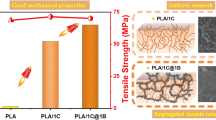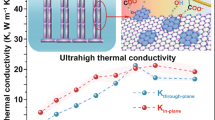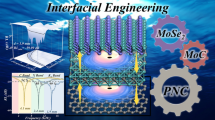Abstract
High permittivity property is hard to achieve in the binary polymer based nanocomposites filled with wide-band-gap semiconductors unless substantial semiconductor fillers are introduced into polymer matrices. The overload of those semiconducting nanofillers usually results in the severe reduction of the mechanical and electric breakdown properties of the composite materials. In this work, the novel ternary polymer based nanocomposites were designed and further fabricated through adding a low concentration of 2D Ti3C2 MXene nanosheets into the binary polymer based nanocomposites containing alpha-SiC nanoparticles. In comparison with the binary composites, these ternary composites could exhibit the notably improved high permittivity properties due to significantly enhanced interface interaction from the introduction of MXene nanosheets. The desirable highly maintained comprehensive electrical properties and mechanical performances have been achieved in those ternary composites. This work might open the door to the large-scale preparation of promising high-permittivity nanocomposite dielectric materials based on building the ternary composite systems.





Similar content being viewed by others
References
N. Pramanik, S. Seok, Jpn. J. Appl. Phys. 47, 531–537 (2016)
X. Zhang, S. Zhao, F. Wang, Y. Ma, L. Wang, D. Chen, C. Zhao, W. Yang, Appl. Surf. Sci. 403, 71–79 (2017)
J. Kim, H. Kim, T. Kim, S. Yu, J. Suk, T. Jeong, S. Song, M. Bae, I. Han, D. Jung, J. Mater. Chem. C 1, 5078–5083 (2013)
Z. Dang, D. Xie, C. Shi, Appl. Phys. Lett. 91, 222902 (2007)
J. Kim, W. Lee, J. Suk, J. Potts, H. Chou, I. Kholmanov, R. Piner, J. Lee, D. Akinwande, R. Ruoff, Adv. Mater. 25, 2308–2313 (2013)
B. Krause, P. Pötschke, E. Ilin, M. Predtechenskiy, Polymer 98, 45–50 (2016)
M. Pastorczak, L. Okrasa, J. Yoon, T. Kowalewski, K. Matyjaszewski, Polymer 110, 25–35 (2017)
H. Lin, X. Wang, L. Yu, Y. Chen, J. Shi, Nano Lett. 17, 384–391 (2017)
Y. Feng, B. Miao, H. Gong, Y. Xie, X. Wei, Z. Zhang, ACS Appl. Mater. Interfaces 8, 19054–19065 (2016)
Y. Feng, J. Zhang, J. Hu, S. Li, C. Peng, Electron. Mater. Lett. 14, 187–197 (2018)
T. Dawin, Z. Ahmadi, F. Taromi, Prog. Org. Coat. 119, 23–30 (2018)
Y. Feng, C. Peng, Y. Li, J. Hu, Materials 11, 1111 (2018)
Y. Feng, Z. Xu, J. Hu, H. Huang, C. Peng, Mater. Res. Express 4, 095001 (2017)
J. Luo, X. Tao, J. Zhang, Y. Xia, H. Huang, L. Zhang, Y. Gan, C. Liang, W. Zhang, ACS Nano 10, 2491–2499 (2016)
Y. Feng, H. Gong, Y. Xie, X. Wei, L. Yang, Z. Zhang, J. Appl. Phys. 117, 094104 (2015)
S. Moharana, S. Joshi, R. Mahaling, J. Appl. Polym. Sci. 134, 45583 (2017)
W. Zhang, Q. Yang, Y. Zhou, J. Cao, Comput. Mater. Sci. 115, 120–124 (2016)
Y. Feng, Y. Wu, Y. Xie, X. Wei, Z. Zhang, Mater. Sci. Semicond. Proc. 61, 63–70 (2017)
S. Guo, H. Wu, G. Chen, X. Chen, Polym. Compos. 24, 456–463 (2010)
D. Banerjee, T. Nguyen, T. Chuang, Comput. Mater. Sci. 114, 209–218 (2016)
S. Jan, A. Zeb, S. Milne, J. Eur. Ceram. Soc. 36, 2713–2718 (2016)
A. Boersma, J. And, M. Wübbenhorst, Macromolecules 31, 7453–7460 (2014)
O. Bulashenko, J. Rubı, V. Kochelap, Appl. Phys. Lett. 75, 2614 (1999)
Acknowledgements
This work was supported by the [National Natural Science Foundation of China] under Grant [Number 51502309] and [Talent Introduction Scientific Research Initiation Projects of Yangtze Normal University] under Grant [Number 2017KYQD33].
Author information
Authors and Affiliations
Corresponding authors
Ethics declarations
Conflict of interest
The authors declare that they have no conflict of interest.
Additional information
Publisher's Note
Springer Nature remains neutral with regard to jurisdictional claims in published maps and institutional affiliations.
Rights and permissions
About this article
Cite this article
Deng, Q., Feng, Y., Li, W. et al. Strong interface effect induced high-k property in polymer based ternary composites filled with 2D layered Ti3C2 MXene nanosheets. J Mater Sci: Mater Electron 30, 9106–9113 (2019). https://doi.org/10.1007/s10854-019-01239-7
Received:
Accepted:
Published:
Issue Date:
DOI: https://doi.org/10.1007/s10854-019-01239-7




